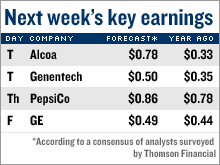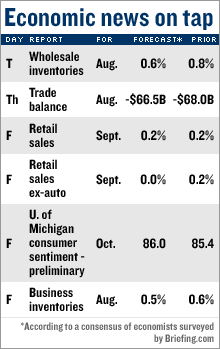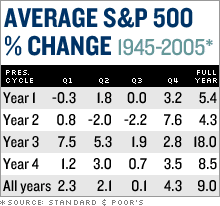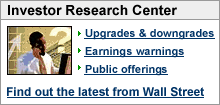|
Bulls to keep running, for now Upbeat investors have pushed the Dow to a record and the S&P 500 to a 5-1/2 year high. The momentum should continue - at least for another week. NEW YORK (CNNMoney.com) -- Come on in. The party's still going. And no one is going to take away the punchbowl. At least not just yet. Yes, the big cap rally that's boosted the Dow Jones industrial average to its highest point ever - and put the S&P 500 at a 5-1/2 year high - is likely to continue in the week ahead.
Sure, stocks got tripped up a little on Friday, following a mixed September employment report. But the declines posted by the market were pretty modest, speaking to the underlying bullishness that has been lifting stocks since August. And with the frame of mind the bulls are in right now, they may just use Friday's declines as an incentive to jump back in Monday. Next week brings the start of third-quarter earnings, with Dow component Alcoa (Charts) unofficially kicking things off Tuesday, as is traditional. (see chart for details) In the longer term, with the economy slowing, a compression in earnings is likely, analysts say. "Nobody knows how much of an economic slowdown we're going to see," said John Davidson, president and CEO at PartnerRe Asset Management. "The most near-term effect (of the slowdown) will be reflected in the reporting of the 3Q earnings." But probably not this week. There are too few S&P 500 earnings on the docket for investors to reconsider current bets that Wall Street will enjoy a 13th consecutive quarter of earnings growth of at least 10 percent. Even the earnings pre-announcement period - typically negative - has so far been uneventful. And, there are few economic reports on the calendar next week to challenge the bulls' hope that the economy is slowing, but not heading for recession, and that the Federal Reserve can remain on the sidelines, as it has since August. (see chart). Or, as the old Wall Street saw goes: the trend is your friend. "Nobody likes to miss out on a party," said Chris Johnson, market strategist at Schaeffer's Investment Research. "There's a sense right now of get on board or miss out." Investors are feeling better The Dow tried to take out its record highs in May, too, but hit a roadblock in the form of rising energy prices, concerns about the economy and questions about when the Fed would end its two-year old interest-rate hiking campaign. Stocks slumped in May and June and meandered in July. But by August, the tone had improved. The Fed took a pass on interest rates at its August meeting and oil prices started coming down. August - typically a rough month for stocks - turned out to be a good one. So did September. Investors jumped back into the market with relish, welcoming oil prices down 25 percent from the July records and continued support from the Fed - which voted to hold rates steady again in late September, but to remain vigilant on inflation. Ultimately, the bulls managed the best third quarter in 9 years and have started the fourth quarter with a bang. Johnson said that even though the S&P 500 and the Nasdaq composite are broader indexes than the Dow 30, and are not making new highs like the blue-chip leader, the perception of your so-called average investor is that the Dow is the market and the market is doing well. That psychology is likely to keep supporting stocks - particularly larger stocks - in the next week or two. At the same time, there's a sector rotation going on in which some of the best performers of the last few years are pulling back and the lagging large caps are benefiting. That's not likely to end soon. "You have money coming out of energy, utilities and small caps and going into the large caps," Johnson added. "There's a sense that large caps are where you want to be right now." There are some threats looming though, particularly as investors move further into what is typically a mercurial month. October, elections and the Fed October is a notoriously tricky month, infamous for some horrendous market crashes and corrections, but also known as a transitional month that ushers in the seasonally strong November through January period. In the last 8 years, October has been a very strong month, according to the Stock Trader's Almanac. However, strong Octobers have followed typically weak Septembers. September 2006 was anything but weak, making some investors wonder if the early fall selloff has merely been postponed, rather than avoided. "I think we are going to pay the penalty for the current strength in the next quarter or two," said David Briggs, head of equity trading at Federated Investors. Stocks could be due for a mild correction even sooner than that as investors get closer to the mid-term elections. On one hand, stocks typically enjoy a period of bullishness in the week before and after the mid-term elections, according to the Almanac. However, with the House of Representatives potentially switching hands - from Republicans to Democrats - this year may prove different. Wall Street is typically seen as preferring a Republican-controlled Congress, in that the party's policies are perceived as more big business friendly. "The market has not fully discounted the impact of a change in administration," said Matthew Smith, portfolio manager at Smith Affiliated Capital. In addition, with investors betting on a sustained slowdown, rather than a recession, economic reports that hint at the latter could ruffle some feathers. But that's probably not going to happen in the week ahead, with the biggest reports due Thursday and Friday, including the Fed's beige book survey of economic activity, the September read on retail sales and the October read on consumer sentiment from the University of Michigan. One possible spoiler: the minutes from the last Fed meeting, due for release Wednesday. Should the minutes show a central bank more worried about the economy than has been illuminated before, investors could see a reason to step back. Short of that, the bulls look to keep the run going. |
|







